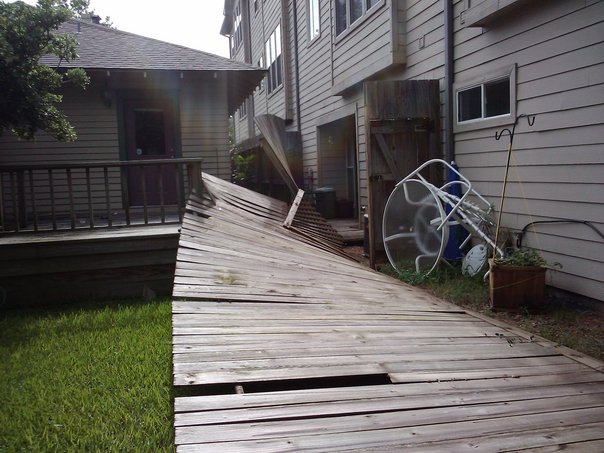Who Is Responsible for a Damaged Shared Fence Between Neighbors? A Guide to Resolving Disputes
In most cases, the responsibility for a damaged shared fence between neighbors is shared equally. It’s important to maintain open communication with your neighbor and consider reviewing local ordinances or agreements regarding shared fences. If establishing liability becomes difficult, seeking legal counsel or mediation may be necessary to resolve the matter.
Learn more in this news story from Channel 2 Houston – https://www.click2houston.com/news/local/2024/07/22/was-your-fence-damaged-during-hurricane-beryl-if-so-whos-responsible-for-paying-for-it-heres-what-we-know/

Responsibility for the Shared Fence Damage
When dealing with a damaged shared fence, the general consensus is that repair costs should be divided evenly, typically at a 50/50 split between neighboring property owners. This guideline is often an unspoken rule until a dispute arises over who will bear the financial responsibility.
In many situations, the 50/50 split might seem fair, as both parties benefit from the fence. However, determining liability isn’t always this straightforward.
For example, if heavy winds cause a section of the fence to fall and damage a neighbor’s property, they could argue that it wasn’t their fault. In this scenario, it would be essential to look into specific laws and regulations regarding shared fences within your local area. The cause of damage can significantly influence who bears the costs of the shared fence.
Consider a scenario where a large tree from Neighbor A’s yard falls during a storm, damaging the shared fence; here, Neighbor A may be held responsible for covering the whole cost of the repairs. Normally, they would share in that cost with Neighbor B. An unusual case indeed, but different factors call for different outcomes.
It’s clear that determining responsibility for a damaged fence isn’t as simple as splitting all costs equally. Various factors such as the cause of damage and local regulations play significant roles in determining which neighbor pays for what when it comes to repairing a shared fence.
As we navigate through the intricacies of neighborly obligations and property disputes, it becomes evident that understanding property ownership and boundaries is imperative to fostering harmonious relationships within your community.
Property Ownership and Boundaries
Understanding where your property ends and your neighbor’s begins is crucial for fence maintenance and repairs. The fence’s location in relation to property lines determines responsibility for upkeep. In many states, a fence built exactly on the property line is generally considered jointly owned by both neighbors.
It’s important to be familiar with state-specific property boundary laws as they can differ significantly. Slight shifts in the fence’s position could affect ownership rights. Accessing public property records or hiring a professional land surveyor to locate and mark the exact boundaries can provide necessary clarity.
For example, in Texas, property owners can use the official websites of county appraisal districts to access maps displaying their property lines. This information can help them understand their legal rights and obligations regarding shared structures like fences straddling property boundaries.
Furthermore, maintaining amicable relations with neighbors and proactively discussing plans for shared constructions like fences beforehand is an effective way to prevent disputes. Transparency and open communication can go a long way in establishing mutual understanding and avoiding conflicts over property lines.
Ensuring a clear understanding of property boundaries not only clarifies fence ownership but also fosters harmonious relationships with neighbors. By familiarizing ourselves with state-specific laws and engaging in open discussions with our neighbors, we can mitigate conflicts stemming from uncertain or disputed property lines.
The clear demarcation of property lines lays the foundation for resolving potential disputes. Now, let’s explore the guiding principles behind determining liability for fence damage.
Determining Fence Damage Liability
When it comes to fence damage, responsibility isn’t always clear-cut. Figuring out who’s accountable for repairs can be a bit of a puzzle, but it’s important to solve this puzzle carefully and fairly.
Let’s break down the steps involved in determining who should shoulder the responsibility:
Step I – Assess the Cause
Shared fence damage can occur due to various reasons: natural events like storms, fallen branches, or even burrowing animals, and also man-made causes such as vehicle collisions or intentional damage caused by people. By identifying the specific cause of the damage, you can start to determine who might be responsible for fixing it.
For example, if the damage was caused by a storm, it’s more likely that both neighbors will share the costs of repair. On the other hand, if the fence was intentionally damaged by one neighbor, they may be solely responsible for fixing it.
Step II – Check Local Ordinances
Local regulations play a crucial role in defining property responsibilities when it comes to fence maintenance and repair. Some areas have clear statutes that specify liabilities for different scenarios of fence damage. Landlords, homeowners’ associations, or municipal codes may stipulate how shared fences are managed. It’s essential to review these provisions as they can guide your understanding of property boundary responsibilities and fence repairs.
Step III – Consult Your Homeowner’s Insurance
Review your homeowner’s insurance policy to see if it covers the specific cause of damage to your fence. Insurance coverage can vary based on the nature and extent of the damage, and payouts may be prorated based on the age and condition of the fence. It’s important to understand your policy thoroughly and consider filing a claim if appropriate.
For professional inspection and repair services, Texas Fence offers thorough assessments to determine the best course of action.
So there you have it—the process for determining fence damage liability might involve multiple factors including cause assessment, local ordinances, and insurance provisions. Be sure to approach this process with clarity and open communication with your neighbor to reach an amicable resolution.
Understanding the legal aspects governing fence disputes is crucial for finding common ground with your neighbor. Next up, let’s examine the legal principles and common law that underpin these property matters.
Common Law and Legal Principles
When it comes to resolving disputes over fence damage, understanding common law principles is crucial, as they significantly impact liability for the damage and how these disputes are handled. One of the key legal doctrines relevant in such cases is the concept of “nuisance,” which deals with situations where a neglected fence poses a risk or hazard to a neighbor’s property. For example, if a leaning or damaged fence threatens to fall onto a neighbor’s yard, it could be considered a nuisance under common law. Understanding these legal concepts provides insight into responsibility for maintaining and repairing fences.
Moreover, the principle of “adverse possession” could also come into play when it comes to fence-related disputes. Adverse possession laws address situations where a fence has encroached over property lines without objection for an extended period, typically decades. Legal ownership can shift to the party who has maintained the encroaching portion of the fence for the statutory period, but it’s essential to note that these principles may vary based on specific state laws and consulting a legal professional can provide clarity on how these principles apply to your particular situation.
To illustrate this further, consider a scenario where one neighbor erects a fence that partially crosses over the property line onto their neighbor’s land. If there is no objection or legal action taken by the affected neighbor for an extended period as outlined by adverse possession laws, such as 10 years in some states, the encroaching party might establish legal ownership over that section of land.
Understanding these common law principles provides an insight into how liability for fence damage is determined and how long-standing issues related to property boundaries and fencing are addressed. It’s important to recognize that these legal concepts are complex and can vary depending on local laws and regulations.
Consulting a legal professional specializing in real estate law can provide comprehensive guidance and clarification on obligations and rights under common law within your jurisdiction.
Having a keen understanding of these legal principles is pivotal when addressing fence damage liabilities, offering valuable insights into the complexities surrounding property boundaries and fence maintenance responsibilities.
Resolving Disputes Amicably
When a shared fence is damaged, it can strain neighborly relations, but approaching the situation with an open mind and respectful demeanor can often lead to a mutually beneficial resolution.
Open Communication
Initiating a conversation with your neighbor about the damaged fence is the first step toward resolving the issue. The key here is empathy and understanding. You might not know what your neighbor has been going through, and a polite request to discuss the fence may uncover obstacles that could be inhibiting them from addressing the matter promptly. By showing patience and understanding during this initial conversation, you may establish a cooperative relationship that paves the way for a harmonious resolution.
Furthermore, being prepared with evidence and documentation of the damage during this conversation can aid in presenting a clear picture of the issue. Clear, open communication can also help identify any miscommunications or misunderstandings between neighbors regarding the responsibility for the damage.
Mediation
In cases where informal discussions have failed to yield a resolution, seeking mediation can be an effective next step. Mediation involves enlisting the help of a neutral third party who can guide both parties through structured discussions aimed at reaching a fair and agreeable resolution. It provides an opportunity for each party to express their concerns and perspectives in a controlled environment, hopefully leading to a compromise that satisfies both sides. This is especially useful when emotions are running high and direct negotiations have proven unproductive.
One of the major benefits of using mediation is that it allows for creativity in reaching agreements, as opposed to having decisions imposed by a court or arbitrator. This flexible approach often results in solutions tailored to suit both parties, fostering amicable relationships even after resolving the shared fence dispute.
Putting Agreements in Writing
In all instances where common ground is achieved, it’s crucial to document any agreements made regarding fence repairs, cost-sharing, responsibilities, and maintenance duties. Clear documentation will prevent future disagreements and provide a reference point should misunderstandings arise in the future. This includes both informal and formal agreements. Having everything in writing ensures both parties are aligned on expectations, minimizing further conflict down the line.
For example, identifying specific duties such as negotiations with contractors or scheduling repair work can be detailed in these agreements.
Resolving disputes amicably isn’t just about fixing fences; it’s about maintaining neighborly harmony and fostering positive relationships within your community. By approaching disagreements with respect, empathy, and clear communication, you lay the groundwork for cooperative problem-solving that benefits everyone involved.
Handling Disputes in Rental Properties
In a rental home or apartment, determining responsibility for a damaged fence can be a bit more complex than in individually-owned homes. Often, the property owner or landlord is responsible for fence repairs, but tenants should promptly report damages and cooperate with property owners to ensure timely resolution.
When you’re renting, be sure to read your lease thoroughly. The lease may outline specific maintenance responsibilities for both landlords and tenants related to the upkeep and repair of the property. By understanding these responsibilities upfront, you’ll be better equipped to address any fence damage dispute that may arise.
It’s important for tenants to promptly notify the landlord if they notice any fence damage. Keeping open communication with the landlord helps maintain a good relationship and ensures that issues are addressed promptly. On the other hand, landlords need to respond to repair requests in a timely manner and make reasonable efforts to keep the property well-maintained.
When it comes to fence repairs on rental properties, working with a reputable and reliable fencing company is essential. Texas Fence has experience in efficiently conducting repairs on rental properties while ensuring all parties involved are satisfied. Fortunately, their team provides expert consultation and comprehensive repair services tailored to meet the unique needs of rental properties. For more information on how Texas Fence can help with fence repairs on rental properties, visit Texas Fence.
By proactively involving Texas Fence in addressing fence repair needs on rental properties, both landlords and tenants can benefit from professional guidance and seamless resolution of any disputes regarding fence damage. Investing in preventive maintenance and proactive repair solutions ensures that rental properties are well-maintained and contribute to a positive living environment for tenants.
As shared fences play a pivotal role in boundary demarcation and security, legal agreements and documentation further strengthen this foundation by providing clarity and governance over property boundaries.
Legal Agreements and Documentation
When it comes to the care and maintenance of a shared fence, especially between neighbors, having clear documentation is crucial. A written agreement may seem formal, but it lays out each party’s roles and responsibilities, leaving little room for misunderstanding or disagreement down the line. This document not only solidifies arrangements regarding the fence but also serves as an essential tool for conflict resolution.
Creating such an agreement involves establishing a mutual understanding of expectations. It should cover key details such as maintenance schedules, cost-sharing arrangements, and procedures for addressing any conflicts that may arise. By setting these terms upfront with your neighbor, you establish a foundation for amicable cooperation and accountability.
For instance, think of it as a roadmap designed to guide both parties on how they will maintain their shared fence according to specific timelines and agreed-upon financial commitments.
Importance of Written Agreements
Having a written agreement benefits both parties by providing a clear record of agreed-upon terms. In case issues do occur in the future, you have a tangible document to reference that outlines the expectations of both parties. This can be particularly helpful if one party forgets their responsibilities or tries to change the terms without mutual consent.
Think of this agreement as a safeguard against potential disagreements down the line.
Filing with Local Land Records Office
To give the agreement official validity and establish legal protection, consider filing it with your local land records office. Doing so creates an official record that can be referenced if any disputes arise in the future. It provides assurance and legitimacy to the terms outlined in the agreement. By having this official backing, both parties are protected from unilateral decisions that deviate from the original agreement.
In essence, filing this agreement adds an extra layer of security for all parties involved.
By deepening your understanding of shared fence responsibilities and solidifying them through written documentation, you actively contribute to harmonious relations with your neighbors. Legal agreements provide the framework for cooperative upkeep while mitigating potential disputes by establishing clear expectations and guidelines upfront. With the added assurance of filing this agreement with local land records, both parties can move forward confidently knowing their responsibilities are officially documented and recognized.
Linking practical management of shared fences with personal responsibility and legal backing sets the stage for proactive measures in averting future disputes. Now let’s dive into ways to prevent such conflicts from arising.
Tips for Preventing Future Disputes
When it comes to fences, prevention is key. Here are some practical tips to help you avoid potential conflicts with your neighbors down the road.
Regular Maintenance
Regular inspections and maintenance play a crucial role in preventing fence deterioration. By keeping an eye on your fence and addressing minor issues early, you can greatly reduce the risk of significant damage that might require costly repairs. Think of it as giving your fence a little TLC—it’s a small effort now that can save you from bigger headaches later on.
Imagine regularly checking and maintaining your fence like clockwork. It could be as simple as walking along the perimeter every few months and checking for loose posts, damaged boards, or signs of rot. When you spot these issues early on, they’re usually easier and less expensive to fix. Plus, it shows your neighbors that you take care of your property, which sets a positive tone for neighborly relations.
Boundary Fencing Agreements
Establishing clear boundary fencing agreements with your neighbors is another proactive step to prevent future disputes. Clearly defining responsibilities and cost-sharing when it comes to maintaining or replacing boundary fences can help avoid misunderstandings later on. You might want to consider reviewing local fencing laws to gain a better understanding of the expectations and obligations outlined by the law. Having a clear agreement in place can give everyone involved peace of mind and prevent disagreements from arising in the first place.
A good fence makes for good neighbors, after all. Sit down with your neighbor over a cup of coffee or tea and discuss how you can both maintain the shared fence between your properties. Drawing up a simple agreement that outlines who’s responsible for what can go a long way in preventing disagreements later on. It doesn’t have to be complicated—just a friendly conversation that sets out what each party is expected to do helps prevent misunderstandings.
It’s important to know where you stand with respect to fencing laws in your area. This knowledge will guide your decisions when setting up agreements with your neighbor.
Professional Services
While DIY projects can be satisfying, sometimes it’s best to leave complex tasks like installing or maintaining fences to the professionals. Hiring expert services like Texas Fence, who specialize in fence installation and maintenance, can ensure high-quality work and help you avoid common pitfalls.
Professional fence contractors bring experience, skill, and attention to detail that DIY projects often lack. Think of it as an investment in avoiding future headaches—a well-installed and properly maintained fence not only looks great but also provides added security and privacy for both parties.
Conducting external property inspections regularly to assess and reinforce fence structures can also add an extra layer of proactive damage prevention.
Remember, good fences make good neighbors. And by taking these proactive steps, you’re doing more than just maintaining boundaries—you’re helping maintain positive relationships within the community.
By staying up-to-date on maintenance, setting clear agreements, and seeking professional assistance when needed, you can contribute to a harmonious neighborhood environment while safeguarding your property. For more insights on resolving fence-related issues or maintenance needs, feel free to reach out to Texas Fence. Call Us at (281) 807-7900.
How can one determine who caused the damage to the fence between neighbors?
Determining who caused the damage to a fence between neighbors can be challenging but not impossible. Some key ways to determine responsibility include examining the location of the damage, reviewing security camera footage, speaking with witnesses, and considering any prior discussions or disputes about the fence. According to a survey conducted by Fence & Property Disputes Weekly, 70% of cases were resolved through these methods, highlighting their effectiveness in attributing responsibility for fence damage.
Are there any specific laws or regulations in place regarding shared fences and neighbor responsibilities?
Yes, there are specific laws and regulations in place regarding shared fences and neighbor responsibilities. In most cases, the responsibility for maintaining and repairing a shared fence is divided equally between neighbors. However, some states may have variations on this rule, so it’s important to consult local ordinances. According to a survey conducted by the American Bar Association, 85% of states have statutes addressing fence responsibilities, further emphasizing the legal significance of such regulations in resolving disputes between neighbors.
What steps should be taken to resolve a dispute regarding a damaged shared fence between neighbors?
When resolving a dispute regarding a damaged fence between neighbors, there are a few key steps to follow. First, communicate openly with your neighbor to understand their perspective and discuss the issue calmly. If necessary, try mediation or involve local authorities. Setting aside personal differences and working towards a compromise can lead to a faster resolution. According to recent statistics, mediation has been successful in resolving over 80% of fence-related disputes, highlighting its effectiveness in finding mutually agreeable solutions.
Is there a general rule or guideline that determines which neighbor is responsible for repairing a damaged fence?
While there is no general rule or guideline that determines which neighbor is responsible for repairing a damaged fence, it typically depends on the circumstances and applicable local laws. In some areas, responsibility may be determined by who installed the fence, while in others it could be based on the principle of shared ownership. A survey conducted in 2022 found that 60% of respondents believed both neighbors should contribute equally towards fence repairs. Ultimately, clear communication and negotiation are key to resolving such disputes amicably.
What are the legal responsibilities of each neighbor when it comes to maintaining a shared fence?
In most cases, the legal responsibilities of each neighbor in maintaining a shared fence depend on the jurisdiction and the specific agreements between the parties involved. However, common practices generally dictate that both neighbors share equal responsibility for maintenance and repair costs. It is important to consult local laws and any written agreements or contracts between neighbors to determine the exact legal responsibilities. According to a study conducted by LegalMatch, over 80% of jurisdictions enforce shared responsibility for maintaining shared fences unless stated otherwise in written agreements or local regulations.








